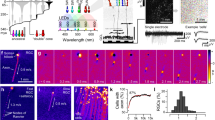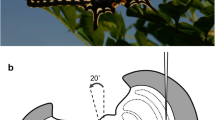Summary
The retina of the gray squirrel (Sciurus carolinensis) contains rods and cones in a ratio of about 2∶3. The spectral mechanisms in this retina were examined in behavioral and electrophysiological experiments. Tests of color vision revealed that this animal has a spectral neutral point at about 500 nm and, thus, dichromatic color vision. Recordings made from single optic nerve fibers and results obtained from an analysis of the flicker photometric electroretinogram (ERG) indicated that vision in the gray squirrel is based on three spectral mechanisms. One of these, presumably rod-based, has peak sensitivity at about 502 nm. The other two mechanisms reflect the presence of two classes of cone having average peak sensitivity of about 444 nm and 543 nm.
Similar content being viewed by others
References
Ahnelt PK (1985) Characterization of the color related receptor mosaic in the ground squirrel retina. Vision Res 25:1557–1568
Anderson DH, Fisher SK (1976) The photoreceptors of diurnal squirrels: outer segment structure, disc shedding, and protein renewal. J Ultrastruct Res 55:119–141
Arden GB, Silver PH (1962) Visual thresholds and spectral sensitivities of the grey squirrel (Sciurus carolinensis leucotis). J Physiol (Lond) 163:540–557
Arden GB, Tansley K (1955) The spectral sensitivity of the pure-cone retina of the grey squirrel (Sciurus carolinensis leucotis). J Physiol (Lond) 127:592–602
Blakeslee B (1983) Electrophysiological studies of spectral mechanisms in the retinas of ground squirrels and tree squirrels. Doctoral dissertation, University of California, Santa Barbara
Blakeslee B, Jacobs GH, McCourt ME (1985) Anisotropy in the preferred directions and visual field location of directionally-selective optic nerve fibers in the gray squirrel. Vision Res 25:615–618
Cohen AI (1964) Some observation on the fine structure of the retinal receptors of the American gray squirrel. Invest Ophthalmol 3:198–216
Dartnall HJA (1960) Visual pigment from a pure-cone retina. Nature 188:475–479
Dippner R, Armington J (1971) A behavioral measure of dark adaptation in the American red squirrel. Psychom Sci 24:43–45
Gouras P (1964) Duplex function in the grey squirrel's electroretinogram. Nature 203:767–768
Green D, Dowling JE (1975) Electrophysiological evidence for rod-like receptors in the gray squirrel, and ground squirrel and prairie dog retinas. J Comp Neurol 159:461–472
Gur M, Purple RL (1978) Retinal ganglion cell activity in the ground squirrel under halothane anesthesia. Vision Res 18:1–14
Jacobs GH (1974) Scotopic and photopic visual capacities of an arboreal squirrel (Sciurus niger). Brain Behav Ecol 10:307–321
Jacobs GH (1976) Wavelength discrimination in gray squirrels. Vision Res 16:325–327
Jacobs GH (1983) Within-species variations in visual capacity among squirrel monkeys (Saimiri sciureus): sensitivity differences. Vision Res 23:239–248
Jacobs GH, Tootell RBH (1981) Spectral response properties of optic nerve fibers in the ground squirrel. J Neurophysiol 45:891–902
Leeper HF, Charlton JS (1985) Response properties of horizontal cells and photoreceptor cells in the retina of the tree squirrel,Sciurus carolinensis. J Neurophysiol 54:1157–1166
Loew ER (1975) The visual pigments of the grey squirrel,Sciurus carolinensis leucotis. J Physiol (Lond) 251:48P-49P
Mollon JD (1982) A taxonomy of tritanopias. Doc Ophthalmol Proceed Ser 33:87–101
Neitz J, Jacobs GH (1984) ERG measurements of cone spectral sensitivity in dichromatic monkeys. J Opt Soc Am A 1:1175–1180
Pokorny J, Smith VC, Verriest G, Pinckers AJLG (1979) Congenital and acquired color vision defects. Grune and Stratton, New York
Silver PH (1966) A Purkinje shift in the spectral sensitivity of grey squirrels. J Physiol (Lond) 186:439–450
Silver PH (1975) A grey squirrel spectral sensitivity by heterochromatic flicker and its implications. Vision Res 16:1235–1239
Tootell RBH, Jacobs GH (1979) A simple surgical procedure for immobilization of rodent eyes. Vision Res 19:1281–1282
Walls GL (1942) The vertebrate eye and its adaptive radiation. The Cranbrook Institute of Science, Bloomfield Hills, Michigan
Weale RA (1955) Bleaching experiments on the eyes of living grey squirrels (Sciurus carolinensis leucotis). J Physiol (Lond) 127:587–591
West RW, Dowling JE (1975) Anatomical evidence for cone and rod-like receptors in the gray squirrel, ground squirrel and prairie dog. J Comp Neurol 159:439–460
Yolton RL (1975) The visual system of the Western gray squirrel: anatomical electroretinographic and behavioral studies. Doctoral dissertation, University of Texas, Austin
Yolton RL, Yolton DP, Renz J, Jacobs GH (1974) Preretinal absorbance in sciurid eyes. J Mammal 55:14–20
Author information
Authors and Affiliations
Rights and permissions
About this article
Cite this article
Blakeslee, B., Jacobs, G.H. & Neitz, J. Spectral mechanisms in the tree squirrel retina. J. Comp. Physiol. 162, 773–780 (1988). https://doi.org/10.1007/BF00610966
Accepted:
Issue Date:
DOI: https://doi.org/10.1007/BF00610966




